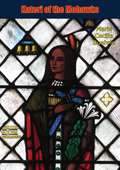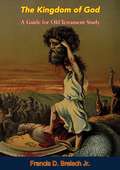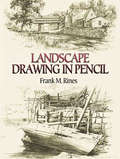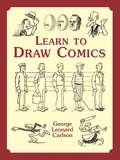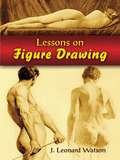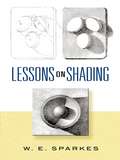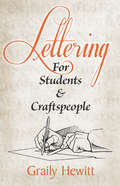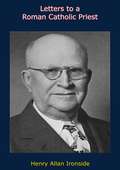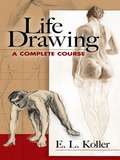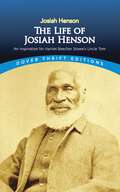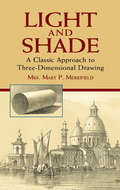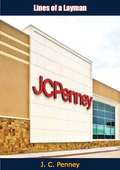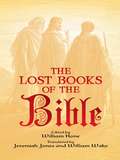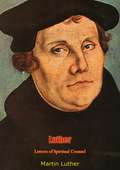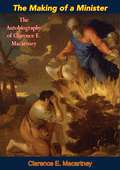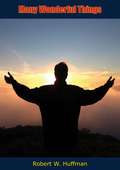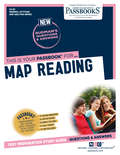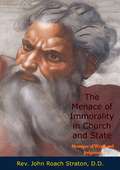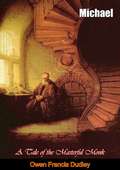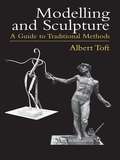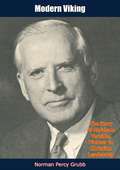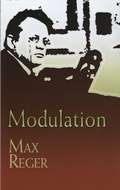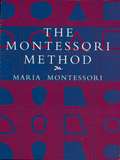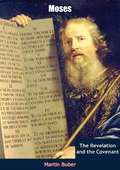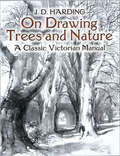- Table View
- List View
Kateri of the Mohawks
by Marie BuehrleFROM SAVAGE TO SAINTFirst published in 1954, this book tells the story of a Mohawk chieftain’s daughter who may soon may be canonized as North America’s first native saint.THE daughter of a Mohawk chieftain, Kateri Tekakwitha was born in 1656. Her mother, an Algonquin Christian captured in a Mohawk raid, was the brief but enduring influence in Tekakwitha’s life. Whatever chance she may have had to teach her child about Christianity was lost when both parents died in a smallpox epidemic.Tekakwitha was ten years old when she heard for the first time of Rawenniio, the white man’s God. But a full ten years passed before a Blackrobe, the Jesuit Father James de Lamberville, baptized her on Easter Sunday, 1676.She practiced her new faith with ever increasing fervor. After fleeing to the mission settlement in Canada, where she could join other Christians in the undisturbed practice of their faith, she performed extreme penances.Through a close companion, Kateri’s words have been preserved for us, revealing the spirit of love and atonement with which she entered into this voluntary mortification. Soon her spent body could no longer contain her soaring soul. She died at the age of twenty-four, leaving all near her convinced that they were witnessing the passing of a saint.
The Kingdom of God: A Guide for Old Testament Study
by Francis BreischIn The Kingdom of God, which was first published in 1959, author Francis D. Breisch Jr. himself perfectly summarizes the message of the Old Testament: “It exhibits the unity which exists in the Old Testament. It shows the historical development of God’s work of redemption. It emphasizes the fact that the entire Old Testament prepares for the coming of Christ, the eternal King. To trace the growth of the Kingdom of God is to keep one’s finger on the pulse of God’s redemptive program. Throughout the guide I have attempted to point out the various ways in which the Kingdom of God comes to expression in the Old Testament.”In his own words, Francis D. Breisch Jr.’s book is geared towards the high school student—“reflected in both form and content”—but readers of all ages will find this volume extremely informative in its expression of the way in which God’s kingdom developed over the centuries.
Landscape Drawing in Pencil (Dover Art Instruction Ser.)
by Frank M. RinesConcise and beautifully illustrated, this guide provides invaluable instruction on the art of pencil drawing. It covers the basics of holding the pencil, applying different strokes, shading, perspective, and the rendering of different textures, as well as the finer points of pictorial composition and drawing from nature.Based on the author's years of experience teaching art students at all levels, this book is ideal for home or class use. Its thirty-six evocative sketches range from English castles to American bridges, with a few detailed close-ups showing how to surmount some of the problems of depicting rocks, roofs, standing water, or leafy tree branches. The accompanying text describes how artists at every level of experience can develop their own pencil technique by employing fundamental rules.
Learn to Draw Comics
by George Leonard CarlsonThis user-friendly guide from the 1930s offers aspiring cartoonists a wealth of practical advice. Rich in period flavor, it supplies the ageless foundations of comic art. Abundant illustrations and clear, nontechnical prose cover: creating expressions, attaining proportion and applying perspective, depicting anatomy, simple shading, achieving consistency, lettering, and writing a strip.
Lessons on Figure Drawing
by J Leonard WatsonDrawing the human form requires a complete vocabulary of skills and techniques. In this concise guide to figure drawing, Watson teaches readers, step by step, everything they need to know to master these valuable methods.Separated into two distinct sections, "Elements of Figure Drawing" and "Drawing From the Figure," readers are treated to nearly eighty drawings, paintings, and photographs that build foundational skills and help analyze anatomy, perspective, light, shade, and composition. From the basics of posing a model and choosing the proper materials, to the importance of measurement, action, median lines, foreshortening, and more, here is an essential treasury of artistic learning and expertise.
Lessons on Shading
by W. E. SparkesIt takes the proper infusion of light and shade to accurately represent an object's solidity and character. With this time-honored guide, artists will easily develop a keener, more educated eye for introducing shadow, light, gradation, and reflection to drawings. This insightful study begins with fascinating artistic experiments and exercises, moving on to illuminating advice on how to deepen volume, evoke sunlight, and create mood. Various shapes such as pyramids, cones, spheres, and vases each necessitate different shading techniques, and are all expertly described in a wonderfully instructive tone and eighty-seven skillful illustrations. Thorough guidance on materials and how they should be manipulated to achieve specific effects is also included in this concise and enlightening resource for artists of all levels.
Lettering: For Students and Craftspeople (Dover Books On Lettering, Graphic Arts, And Printing)
by Graily HewittBoth a history and a how-to book, this landmark work by a great British calligrapher is required reading for every serious student of the art. Graily Hewitt introduces the general principles and the importance of the pen in the history of writing, tracing the development of minuscules and majuscules and other lettering styles. He then devotes a major portion of the book to Roman capitals, arrangement, legibility, and materials, including pens and inks, paper and parchment, pigments, gilding, and other methods. Full, detailed chapters on numerals, the double stroke, the theory of letters, and other topics round out the text.More than 400 illustrations offer instructional guidance on correct form, spacing, proportion, serifs, paragraph initials, raised letters, and much more. Complete letter-by-letter sequences show how to write the alphabet in formal minuscule and Roman capitals. In addition, samples of great calligraphy from Greek and Roman sources, The Book of Kells, medieval Italian manuscripts, and the author's own work document the glorious results achieved by master calligraphers of the past.
Letters to a Roman Catholic Priest
by H. A. IronsideWhat does the Bible say about...Roman Catholic Doctrines?Originally published in 1914, this booklet written by H. A. Ironside contains personal letters addressed to a parish priest of the Church of Rome, whose acquaintance Pastor Ironside made on a railway journey:“It was a pleasure to converse with this cultured gentleman. When we parted, he accepted from me a small volume dealing with a portion of Holy Scripture. Afterward he wrote me a very appreciative letter about the topics with which the book was concerned. There began a correspondence, which is being published with the hope that they may prove helpful to the reader.”—H. A. Ironside
Life Drawing: A Complete Course
by E. L. KollerThe human figure, with its myriad curves and contours, can be challenging for anyone to draw. In this invaluable reference, well-known art instructor and author E. L. Koller simplifies the process, making it easy for artists to learn new methods of rendering the figure--in action and repose--with accuracy and style. Using figure-drawing exercises, numerous photos, and illustrations, Koller reduces the task at hand into manageable steps for intermediate and advanced artists. Beginning with drawing basics, this step-by-step guide explores the structure of the human figure and the comparative proportions of child and adult figures, showing how to depict individual parts of the head and body, facial expressions, and gestures. It also shows the merits of sketching from memory; drawing from casts, photographs, and living models; and sketching both undraped and costumed figures. Once the still figure is mastered, the artist can explore the more challenging action poses, including walking, running, and catching. Filled with guidance and insight on the human form, Life Drawing is an essential addition to every artist's reference shelf.
The Life of Josiah Henson: An Inspiration for Harriet Beecher Stowe's Uncle Tom (Travel In America Series)
by Josiah HensonBorn into slavery on a Maryland farm, Josiah Henson (1789–1883) worked as a foreman, married, and became a preacher in the Methodist Episcopal Church. Faced with the prospect of separation from his family, Henson fled with his wife and children to Ontario, where he became a leader in the Afro-Canadian community. The Life of Josiah Henson, Formerly a Slave, Now an Inhabitant of Canada, as Narrated by Himself first appeared in 1849. The book's avid readers included Harriet Beecher Stowe, who later acknowledged its influence on her own masterwork, Uncle Tom's Cabin.Henson's narrative recounts the circumstances of his bondage, his conversion to Christianity, and his fruitless attempts to buy his freedom. Risking starvation, exposure, and recapture, the Henson family walked from Kentucky to Ohio. Native Americans assisted the struggling family, as did sympathetic boatmen who ferried them across Lake Erie. Safely established as a tenant farmer and clergyman in a new country, Henson took an active role in organizing a self-sufficient community. His memoirs helped alert his contemporaries to the horrors and heartbreak of slavery, and they offer modern readers an authentic account of one family's triumph over injustice and inhumanity.
Light and Shade: A Classic Approach to Three-Dimensional Drawing
by Mary Merrifield"Form," writes the author, "is developed by means of light and shade; without these every object would appear flat." Originally published in the mid-nineteenth century, this classic approach to three-dimensional drawing was the first book to provide art students with instructions for correctly illustrating perspective outlines of various objects. An art historian noted for her authoritative reference works, Merrifield clearly demonstrates the principles of light and shade by revealing the effects of common daylight, sunshine, and candle or artificial light on geometrical solids. Her simple explanations are accompanied by illustrations of cubes, prisms, pyramids, cylinders, spheres, ovals, and cones.As useful and practical today as it was when first published well over a century ago, Light and Shade provides beginning and advanced art students with valuable insights into effective drawing and sketching.
Lines of a Layman
by J. C. PenneyThe history of America’s commercial growth is highlighted with the names of a few great men whose contributions to their nation have far transcended ability in business, manufacturing and industry. Elbert Hubbard, John Wanamaker—these men were merchant princes in one sense, leaders of thought and belief in another. Through their autobiographical writings and essays, they have given us a rich, poignant, inspiring picture of their fruitful lives and careers. Their words point the way to meaningful, creative, productive and brotherly living.Such a man is J. C. Penney, at once the most successful of our times in business enterprise, and the most inspiring in his personal example of courage, wisdom, and service to fellow men and to God.Faith and fellowship are no mere Sunday things in J. C. Penney’s philosophy. You find a twenty-four-hour-a-day, seven-day-a-week code of Christian living in such pieces as his Six Principles for Daily Living, The Four Square Man, and The Christian and the Social Order. They are “the measure of the man.”You will find LINES OF A LAYMAN more than a book to read, although its almost 200 thoughtful vignettes are fascinating, swift-paced and stimulating. You will find that it is a book to use, even a book to live by. Its pages are charged with meaning; one cannot read them without finding new ways to happiness and creativity.
The Lost Books of the Bible
by William Wake Jeremiah Jones William HoneRediscovered in modern times, these "non-canonical" gospels, epistles, and other pieces were excised from the standard Bible by various church councils in the first four centuries of the Christian era. Here, among other texts, are writings describing the girlhood and betrothal of Mary and her life before Christ's birth; the childhood of Jesus, as described by Peter and Nicodemus; and the appearance of Christ before the gates of Hell, from whence he leads Adam and the saints to Paradise.Translated from the original languages, with 32 illustrations from ancient paintings and missals, The Lost Books of the Bible, helps give depth to the historical characters of Jesus, Mary, the apostles, and other figures of the New Testament. Presented without argument or commentary, these apocryphal texts are fascinating, often provocative, reading. An essential resource for the study of biblical history and theology, this authentic presentation of the "lost" Scriptures can be enjoyed for its beauty and directness, while also adding to one's understanding of life in Judea during the first century A.D.
Luther: Letters Of Spiritual Counsel (The Library Of Christian Classics Ser. #No. 54)
by Martin Luther Theodore G. TappertMartin Luther is often thought of as a world-shaking figure who defied papacy and empire to introduce a reformation in the teaching, worship, organization, and life of the church. Sometimes it is forgotten that he was also a pastor and shepherd of souls. Collected in this volume are Luther’s letters of spiritual counsel, which he offered to his contemporaries in the midst of sickness, death, persecution, imprisonment, famine, and political instability. For Luther, spiritual counsel was about establishing, nurturing, and strengthening faith. Freshly translated from the original German and Latin, these letters shed light on the fascinating relationship between his pastoral counsel and his theology.“Since spiritual direction is not the wholesale application of general principles, but the painstaking working out of spirituality in specific situations, the personal letter is one of its best expressions. Luther knew the holy gospel and the human heart, and the double knowledge is evident on the pages of these letters.”—Eugene H. Peterson, Regent College
The Making of a Minister: The Autobiography of Clarence E. Macartney
by Clarence MacartneyOriginally published in 1961, The Making of a Minister is Clarence E. Macartney’s autobiography—the story of a man who was a great preacher, a Civil War scholar, a skilful and prolific writer, and the leader in the evangelical movement in its time of greatest crisis….A ‘minister’s minister,’ who, personifying the highest ideals of his calling, was also and foremost a ‘folk’ minister, with the compassionate heart of a true shepherd.
Many Wonderful Things
by Robert Huffman“SOMETIMES GOD TAKES UNUSUAL METHODS TO ATTRACT ATTENTION TO HIMSELF…”This book brings you the amazing true story of one of the most unusual events of our day—proof through hypnosis that God has placed a part of Himself within you!In a series of hypnotic experiments carried out over a period of two years, the Boulder Fellowship Foundation has uncovered startling evidence that man has a “third mind—a God mind, a part of God within himself. While hypnotism is not the theme of this book, it was the tool used to show that the subconscious mind—as well as the conscious mind—can be stilled, thus allowing the God-part to speak without the intrusion of the ego. The result?—pure truth brought forth from the God part at the God level!The answers to questions put to the God-part of the subject used in these experiments are truly amazing. As you read them in this book, they will speak of many wonderful things, and point the way to your greatest adventure—partnership with God…adventure into Eternity!“Proving God within ourselves is an adventure, a challenge, a joy,” the God-part tells us. “Now is the time to claim this challenge, to step forth to this adventure. For this is our one requirement: to recognize God within, to express God from ourselves to all men; thus bringing forth the greatest, the most glorious adventure in all eternity!”THE GOD-PART SPEAKS TRUTH WITH NO CONFUSION!The hypnotic experiments reported in this book uncover some revealing answers to scores of perplexing questions. Here are just a few:Where can I find God?How can I get to God?What is God like?How can I truly contact Him?Is here really life after death?What is man’s destiny?How can I find true peace of mind?Does God punish us?Is there really a Hell?What is death?What is God’s will for me?What is the greatest power in the Universe?Can God heal me? Will He?Read the easy-to-understand answers to these and many more questions in this book.
MAP READING: Passbooks Study Guide (General Aptitude and Abilities Series (CS) #Vol. 17)
by National Learning CorporationThe General Aptitude and Abilities Series provides functional, intensive test practice and drill in the basic skills and areas common to many civil service, general aptitude or achievement examinations necessary for entrance into schools or occupations. The Map Reading Passbook® prepares you by sharpening the skills and abilities necessary to succeed in different types of civil-service positions. It provides hundreds of multiple-choice questions that include, but are not limited to: understanding and interpreting maps and directions; and more.
The Menace of Immorality in Church and State: Messages of Wrath and Judgment
by John D.“THE following messages are printed in response to many requests for their publication. I have allowed the local coloring to remain in the discourses, because I felt that these elements might add to the vitality of the messages, and make them more concrete and real.“I have not softened the messages, either, by ‘retouching’ them. These messages were stenographically reported, and they are given here just as God gave them to the messenger,—hot from the heart.“Happily, however, we are getting away from that false modesty which is not willing to talk about these evils, in order that they may be exposed and corrected, but is willing to tolerate them in guilty and shameful silence. We need to substitute the challenging tones of truth for this cowardly and prudish reserve. We need to speak out. We need knowledge of these secret enemies of our homes. These evils feed on silence and grow by stealth, and we ought today to tell the whole truth and not compromise with evil. ‘Ye shall know the truth and the truth shall make you free.’ As in Hosea’s day, thousands and tens of thousands are being ‘destroyed for lack of knowledge.’ Men and women, boys and girls,—our children, our brothers and our sisters,—are going down. Surely it is our duty to unmask the sources of their destruction, and to seek by all honest and legitimate means to defend ourselves against these secret assailants of the sanctity of the church, the purity of the home, the good order of the state, and the very life of the nation itself.After every war, there is a wave of immorality. We have just passed through the greatest war of all time, and we are now witnessing the widest wave of immorality in the history of the human race. Like a consuming fire, it is sweeping over the world. Only a spurious and silly optimism can deny this fact. All who really know conditions, both in Europe and America, confirm the fact.”—Rev. John Roach Straton
Michael: A Tale of the Masterful Monk
by Owen DudleyAgain, as in his tremendously popular earlier books, Owen Francis Dudley deals with the problems of human happiness. In this new novel his talent for storytelling seeks its expression in highly dramatic incidents which take place in a variety of settings and with a fresh cast of fascinating characters.The action moves across half a world, from England to the South Seas, and begins on a steamer bound for New Zealand, where Father Thornton becomes a confidant of Michael St. Helier. Introverted and unfriendly, this young man in an accident on shipboard behaves in a manner which is interpreted as cowardice. The Masterful Monk finds that extreme sensitivity and an unhappy home life have brought about a morbid revulsion from ugliness and violence and a refusal to accept pain or sacrifice. Recognizing the psychological problem involved, he takes young St. Helier in hand and becomes his friend and mentor. With unflagging interest the reader follows the steps by which, through many trials and adventures, Michael is brought face to face with his own problems and is able, in the end, to confront his future with courage. A tender love story is interwoven in this compelling novel.
Modelling and Sculpture: A Guide to Traditional Methods
by Albert ToftA student of the great Edouard Lanteri and a celebrated sculptor in his own right, Albert Toft created this manual to offer students every practical detail necessary for a complete knowledge of modeling and sculpture. Both professionals and amateurs will find Toft's experienced guidance a valuable help in surmounting difficulties and avoiding errors. Topics include:*Modelling a portrait bust*Casting*Modelling for terra-cotta, in relief, and for bronze*Modelling in clay as a prelude to working in stone and woodThirty-six plates and eighty-two line illustrations enhance this manual, and a helpful glossary defines the most common terms.
Modern Viking: The Story of Abraham Vereide, Pioneer in Christian Leadership
by Norman GrubbThis is the fascinating story of the International Christian Leadership Movement and its founder, Dr. Abraham Vereide. I.C.L. is known around the world especially for its sponsorship of the annual Presidential Breakfasts in Washington, D.C., and this book contains many interesting sidelights on these famous events and personalities.Political leaders in Washington are warm in their praise of Dr. Vereide and his work:Congressman Charles E. Bennett says, “Abraham Vereide originally envisioned this Group—the House Breakfast Group which meets every Thursday morning for prayer, discussion and Christian fellowship—the most significant thing I know on Capitol Hill. I consider him to be one of America’s greatest citizen-leaders and one of our Master’s greatest tools for good.”“Reading the life story of Abraham Vereide is like boarding a fast-moving train,” writes the reviewer in Faith at Work magazine, “for here is a man who has been hurtling through life since childhood and now, in his mid-seventies, is still going strong. Though Vereide is Norwegian by birth, it is difficult to think of him except as the American pioneer, and the various stages and episodes in his life epitomize the best of the forces that shaped this nation.“The story of the development of International Christian Leadership is only slightly less interesting than the story of Vereide himself. And the names that dot the pages!—presidents of the United States, kings and queens, French diplomats, members of Parliament, African and Indian leaders, millionaires, governors, and great Christians of all kinds: Graham, Sunday, Peter Marshall, Schweitzer, Shoemaker, Bob Pierce, Peale. No less interesting are the anonymous men and women whose stories gleam through the swift-paced narrative: the mining camp rowdies, alcoholics, taxi-drivers, churchmen. All in all, this volume is a significant achievement.”
Modulation: Music Book Index
by Max RegerIn addition to his international renown as a teacher, conductor, and pianist, Reger wrote more than 1,000 works in virtually every musical genre. Many scholars and musicians credit him with emancipating dissonance to a level that assisted Schoenberg's development of serialism in the 1920s. Reger's influence extends to other 20th-century composers, including Béla Bártok, Alban Berg, Arthur Honegger, Paul Hindemith, and Sergei Prokofiev.Modulation — the change from one key to another — is a subject of critical importance to performers and composers in their study of harmony. Reger wrote this concise guide to modulation while teaching composition at Leipzig Conservatory, and the work continues to provide valuable insights and instruction for musicians at all levels. This new edition features newly engraved musical examples.
The Montessori Method
by Maria MontessoriThis is, quite simply, one of the landmark books in the history of education. Written by influential Italian educator Maria Montessori (1870–1952), it describes a new system for educating young children based on materials and methods she originally developed to teach retarded students. The techniques proved highly effective with normal children as well. Her system, based on a radical conception of liberty for the pupil and a highly formal training of separate sensory, motor, and mental capacities, led to rapid and substantial mastery of reading, writing, and arithmetic. In The Montessori Method (1912), her first book, Dr. Montessori outlines her techniques in discussions of such topics as scientific pedagogy; discipline; diet; gymnastics; manual labor; education of the senses; methods for teaching reading, writing, and arithmetic; and many other topics. The Dover edition is the least expensive edition available, making this seminal classic widely accessible to teachers, principals, parents — anyone interested in the education of young children.
Moses: The Revelation and the Covenant
by Martin Buber“To the best of my knowledge,” writes Martin Buber of this book, “what has been essayed here is the first comprehensive attempt of its kinds.”Buber—steeped as he is in the literature of the Old Testament—here seeks to disengage history from saga and to convey the meaning of Sinai to the 20th century.“In this book a fascinating attempt is made to depict the historical Moses. The work is rich in brilliant comment. He has profound things to say on the flight of Moses to Midian, where he met with a life resembling that of his ancestors; on the Burning Bush, where he saw fire, but no form; and Moses before Pharaoh, as the first historical instance of prophet versus king; on the contrast between Moses summoned by God, and Balaam, made use of by Him. The style is invariably clear, precise and dignified. This is a book to be read, re-read and treasured.”—David Daube, Regius Professor, Oxford University
On Drawing Trees and Nature: A Classic Victorian Manual with Lessons and Examples
by J. D. HardingThis classic of art instruction is the work of James Duffield Harding (1798-1863), who served as drawing master and sketching companion to the great Victorian art critic, John Ruskin. Generations of students have benefited from the teachings of this 19th-century master, who sought always to "produce as near a likeness to Nature, in every respect, as the instrument, or material employed, will admit of; not so much by bona fide imitation, as by reviving in the mind those ideas which are awakened by a contemplation of Nature . . . The renewal of those feelings constitutes the true purpose of Art."This volume consists of direct reproductions of Harding's sketches of vignettes from natural settings. Each is accompanied by a series of lessons emphasizing both practical and theoretical considerations. The edition features the added attraction of 23 outstanding plates from the author's Lessons on Trees.
